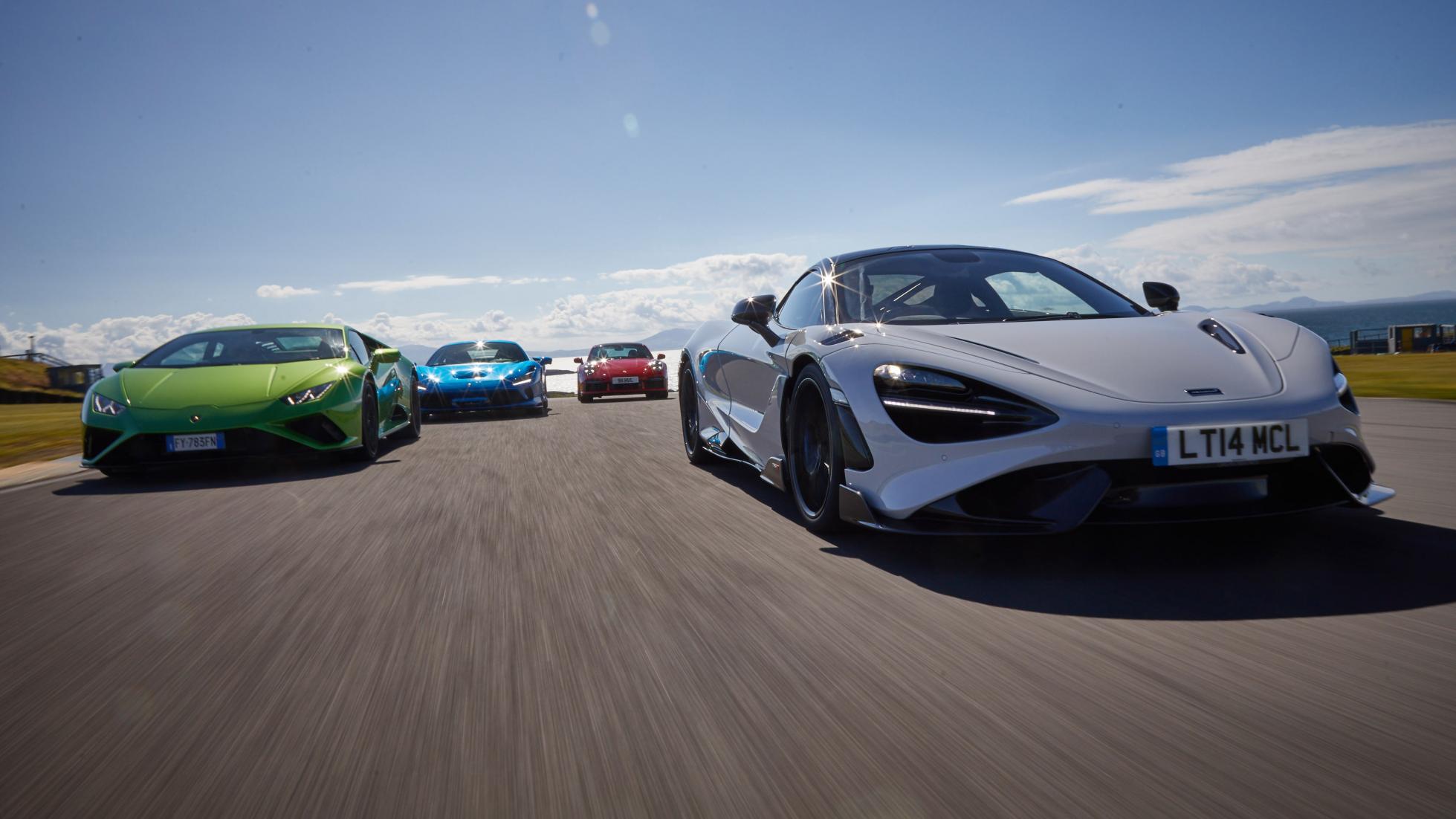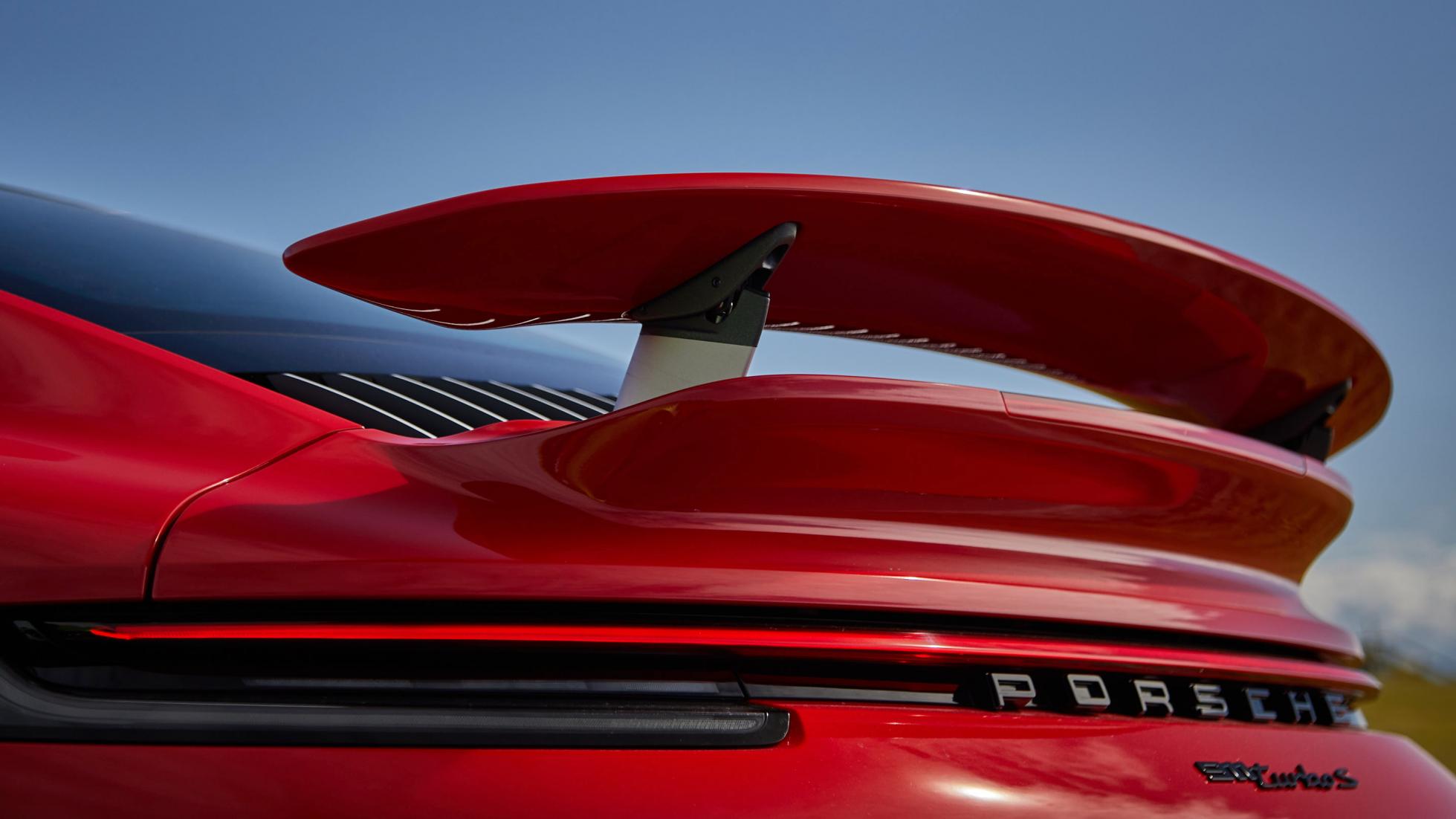Speed Week 2020: McLaren, Ferrari, Lambo and Porsche vs the clock

Have you already read the comparison test of these four? You might want to do that first. Here we’re looking at the numbers. These are four extremely fast cars. The slowest hits 100kph in 3.3secs and 160kph in 6.4. It’s a hard figure to get your head around if you haven’t experienced anything like that before, so here’s a possibly-not-helpful reference. If you jump out of an aeroplane and experience pure freefall, you’ll hit 100kph in somewhere between 2.7 and 3.1 secs. Faster with your head down and arms back, slower if you go for maximum surface area. That’s a force of 1g.
Having jumped out of a plane before, I can categorically describe the experience as ‘breathtaking’. Still unsure? During freefall it takes about 40 metres to accelerate to 100kph. The approximate height of a 12 story building. Think about knocking a bottle off a balcony that far up. Think about how fast it appears to accelerate. I know, smaller things look faster, but the physics don’t change. 1g of acceleration – or deceleration – is a lot. All of these cars can better gravity. But which bosses it best of all?

Yes all of them, including the Lamborghini, can better gravity in one particular way: stopping. All pull over 1g of deceleration all the way from 160kph to 0. The McLaren 765LT, easily the lightest and with the most exotic brakes, was the best. It averaged over 1.2g and stopped from 160kph in an astonishingly brief 73.2 metres – ten metres (or two car lengths) shorter than the Lamborghini (83.9 metres) and Ferrari F8 (82.9 metres).

I’m going to mention the Porsche separately for one particular reason. Porsche has long claimed that braking performance was every bit as important as acceleration. About 20 years ago you’d hear Porsche engineers saying that a car should be able to stop in half the time it took to go. I’m not sure if it was ever an official line, but it was common knowledge.
And naturally it’s been quietly put down now. Brakes have improved, but the technology hasn’t changed markedly – you still just grip a disc between two pads and lean as hard on the tyres as you can. ABS will get involved if it needs to. That system has been refined and improved, but just look what’s happened to power and performance. 20 years ago quick cars were hitting 100kph in 5 seconds, and stopping in about 2.7-2.9secs. All good.
Now, thanks to twin clutch gearboxes, launch control systems and the like, acceleration times have been slashed almost in half. But only a few tenths have been lopped off the brakes. Anyway, After the McLaren, the Porsche 911 Turbo S leads the way here, stopping from 160kph in 79.8 metres. And that despite being the heaviest.
OK, on with acceleration. Even if this is a skid shot. All four have launch control. The Lambo is the only one that refers to it as Thrust Mode. Because of course it does. Anyway, this is the rear drive Huracán, so it was never going to match the 2.8secs 0-100kph of the 4WD car.
However, once up and running it’s actually quicker than the 4WD car (less weight making up for the 30bhp power drop), getting from 50-160kph in 4.48secs rather than 4.72. Don’t forget it’s the least powerful car here, the Lambo, with 602bhp against the 641bhp Porsche, 700bhp Ferrari and 755bhp McLaren. Not that outright power is that helpful initially – it’s all about how much you can get out of the tyre. That’s why launch control helps so much. Unfortunately, Thrust Mode is comparatively crude, so a 3.36secs 0-100kph time left the Huracán adrift of the…
… similarly specified Ferrari F8 Tributo. Both rear-drive with twin clutch gearboxes. However, Ferrari’s more sophisticated launch system enabled the F8 to just sneak under the three-second barrier to 100kph, recording 2.96secs.
From that point on, the F8’s power-to-weight advantage can take over. From 100-210kph the Huracán needed 6.65secs, the F8 almost exactly a second less (5.67secs).

But guess which car is trailing when you throw the Porsche into the mix (hint: the picture is a BIG clue)? Nothing gets off the line like a Porsche 911 Turbo S. It’s not just the astonishing traction which feels like the tyres have grown claws, but how the power and torque is managed. Somehow, without blowing apart clutches, driveshafts or any other bits further up the drivetrain, all 641bhp and 800Nm appears able to arrive at all four wheels immediately. It’s an uncanny use of mechanics and electrics. And deeply uncomfortable for those experiencing it. End result? 0-100kph in 2.48secs.
However, that’s not the whole story. Because although the Turbo S appears able to defy physics (peak g reading of 1.32 off the line) at low speeds, as you go faster, its power to weight shortfall (the least here at 391bhp/tonne) starts to come into play. That 100-210kph increment? Takes 6.76secs in the Turbo S, the slowest here.
Mother of god, the McLaren is fast. No 2WD car should be able to get itself off the line like this, even one fitted with Pirelli’s stickiest Trofeo R tyres. 2.72secs to 100kph, and came perilously close to dipping under 5secs to 160kph (5.08secs). 1.5secs after that it was at 200kph.
Looking back through the records, it’s as quick to 160kph as either a McLaren P1 or a Porsche 918 Spyder (both of which posted 5.0secs to 160kph). Its 100-210kph time of 5.09secs left the rest standing, half a second ahead of the Ferrari, a second and a half quicker than the others.
As a result, this is the only view any of the others would have of the McLaren in a drag race. Once it had gathered up the fast-starting Porsche at least.
Other highlights? From a standing start it went through 100 metres in 4.56secs at a terminal velocity of 147.1kph. Didn’t have enough space for a quarter mile, but McLaren’s claim of 9.9secs is probably about right given we recorded a 10.19secs at 235kph in a regular 720S.

How does the McLaren do this? Simple: more power, less weight. Its engine (now viewable through an optional porthole on the rear parcel shelf) delivers 755bhp (765PS) and 800Nm. The power is a lot higher than rivals, but it’s torque that gives you acceleration and 800Nm is the same as the Porsche and not much ahead of the 785Nm Ferrari. The torque weakling is the 560Nm Lamborghini – the only naturally aspirated car here.
The rest rely on turbos. And beyond that McLaren relies on light weight. At 1,339kg it has over 100kg less than any rival to push along, and actually the best part of a third of a tonne less than the Porsche. No wonder it hits so hard.
I know, figures aren’t as quick as in US mags, but we don’t use one foot roll out and we don’t use high grip tarmac, just regular road.

All will top 322kph, but above that they’re all pretty closely stacked between the slowest (325kph Huracán Evo RWD) and fastest (340kph Ferrari F8 Tributo). The Porsche and McLaren tie on 330kph. We didn’t have room to test this out – you need a lot of space – so we don’t know if they simply run out of puff due to aero reasons, or chirp into the rev limiter in top gear. Either way, top speed doesn’t really matter – it’s how you get there that counts.

Which potentially means that the car that feels the fastest, isn’t the fastest. Because from the driving seat, without the help of a VBox you could make a case for any of these being the quickest. The torque immediacy and impact of the Ferrari when you roll on to the throttle is immense, there’s the Porsche’s sudden impact off the line and the McLaren’s utter savagery over the last 2,000rpm of the rev range and the sheer force it supplies above 160kph.
And then there’s the Lambo. Because when it comes to drama, noise, immersion and everything else, you could actually make a strong case to suggest that the slowest car here feels the fastest.
Words: Ollie Marriage












